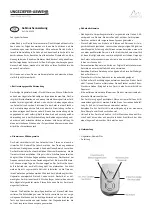
GSM-4S SATEL
15
forward an SMS to a different number than that programmed in the module, it is necessary to
insert this number after the control message in the following way: "xxxx=yyyy.", where "xxxx"
denotes the control code, and "yyyy" – the telephone number to which the message is to be
sent by the module. Put the equality sign before the telephone number, and the dot after the
telephone number.
Controlling all outputs simultaneously or bypassing/unbypassing the inputs is confirmed by
the message on the present status of all inputs and outputs of the module as well as the
telephone line status, test transmission period and current telephone numbers to be notified.
The message transmitted by the module can have one of the following forms:
•
OUT [n] switched ON (status: OT1 = ? OT2 = ? OT3 = ?)
•
OUT [n] switched OFF (status: OT1 = ? OT2 = ? OT3 = ?), when character "[n]" is
replaced with the output’s number: 1, 2 or 3.
•
Status: IN1 =?, IN2 =?, IN3 =?, IN4 =?, outputs: OT1 =?, OT2 =?, OT3 =?, LT=?, test:
??d??h??m Tel1=?...? Tel2=?...? Tel3=?...? Tel4=?...?
For designation of the output, character "?" is replaced with the logic state (i. e. the status) of
the output:
0 – output switched OFF (inactive),
1 – output switched ON (active).
For designation of inputs, character "?" is replaced with the letter:
i or
t
– input in normal status unbypassed (non-violated),
I or T
– input unbypassed violated,
b
– input bypassed.
For the telephone line designation, the "?" character is replaced with the following ones:
ok
– the telephone line in good working order,
??
– the telephone line out of order.
In the test field, the module will send the currently programmed number of days, hours and
minutes of the test transmission period.
In the telephone number description, the ?...? characters are replaced by the programmed
telephone number to be notified.
Note: The module always acknowledges the stable status, in which the output remains
after completing the control (for the monostable switched output – the status in which
the output will go after the switching time expires).
9.1.3
Controlling outputs by means of CLIP function
The module allows you to control the outputs by using the CLIP feature. To this end you
should call the module number from a corresponding telephone number. The module will
decode the number from which the connection is initiated, count the "calling time", reset the
connection and perform control. If the module user answers the call earlier from the
extension line (T-1, R-1), or if the calling party hangs-up, the function will be interrupted and
the control will not be performed.
An option is provided to save 4 telephone numbers in the module memory and assign to
these numbers suitable control of one output or some outputs simultaneously. Operating
mode of the outputs is much the same as for control of the zone violation.
In order to start the CLIP control function, you should:
•
program the Calling time (keep in mind that for value "0" the module will not answer any
calls, thus making control through CLIP impossible),
•
program the functions from the CLIP control submenu (telephone numbers, way to control
the outputs).
















































